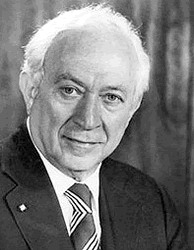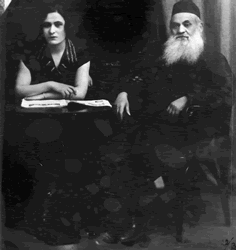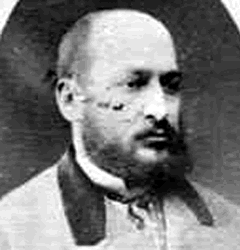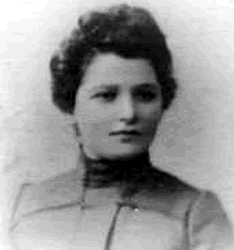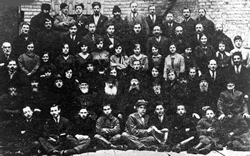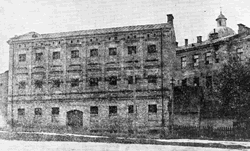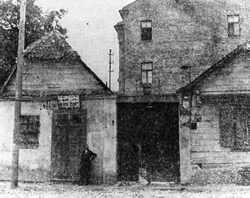ROMM: a family of printers
By : Joseph Jacobs Peter Wiernik
Family of printers and publishers of Hebrew books in Wilna. The family formerly lived in Grodno, where the book-dealer Baruch b. Joseph Romm established a printing-office in 1789. The Romm Hebrew printing-office was the first in Lithuania, and its authorization by King Stanislaus August was considered an important event. In 1799 Baruch removed to Wilna, where he died April 29, 1803. The business was inherited by his son Menahem Man Romm, who in 1835 began, in partnership with Simḥah Zimel of Grodno, the crowning effort of a Jewish printer's career—the publication of a new edition of the Talmud. The first volumes of that edition bear the imprint "Wilna and Grodno"; the later volumes have that of Wilna only; but the work was really done in Ozar, near Grodno. Menahem Romm died Oct. 13, 1841, and was succeeded by his only son, Joseph Reuben Romm, under whom the printing-house was formally established in Wilna in 1847, although the report of a conflagration ("Allg. Zeit. des Jud." 1840, No. 20) proves that it had even previously been of considerable size and importance. He died Feb. 28, 1858, and left three sons, David, Ḥayyim Jacob (d. Aug. 30, 1869), and Menahem Gabriel. David, who was the head of the firm, died suddenly March 9, 1860, while on his way from St. Petersburg, where he had obtained a practical monopoly of the Hebrew printing and publishing business in Russia. After his death the monopoly was broken, and numerous printing establishments sprang up in various parts of the empire. In 1863 the present firm name, "Witwe und Brüder Romm," was adopted; and the house has maintained its position as the foremost Jewish publishing concern in Russia, if not in the world. Deborah Romm, David's widow, took an active interest in the firm's affairs until her death on Dec. 3, 1903. Three of her sons reside in New York.The Russian Hebraist Mordecai (Marcus) Plungian was corrector in Romm's printing-office from 1869 to 1873. Bibliography: Steinschneider, Hebr. Bibl. ii. 58; iii. 22; iv. 50, 126, 153 (Benjacob's list); Aḥarit Dabar, note at the end of the treatise Niddah of the latest edition of the Babylonian Talmud , Wilna, 1897.J. P. Wi.
A Jewel in the Crown of a Renowned Torah Center
Vilna won a reputation that outshone those of far larger and better-known communities, giving it the name, "the Yerushalayim of Lithuania." The community was renowned for its distinguished rabbonim, its numerous talmidei chachomim and its learned residents. The mere fact that the Gaon lived there would alone have sufficed to elevate the entire town and bring it renown.
One institution that was an integral component of Vilna's intense Torah life was the printing house of the Widow and Brothers Romm. It made a sweeping and pivotal contribution to the Torah world that remains with us to this day.
In recording Vilna's eminence among other communities, a contemporary writer noted the role played by this printing house in achieving the town's renown. He writes that, "Vilna's great fortune -- and an important factor in its fame -- were its printing houses, which distributed the largest and most important body of literature in our lives -- rabbinical and scholarly literature, from prayer books to the large, handsome Shas -- to every country and town where Jews dwelled. The Widow and Brothers Romm operated the largest printing house, store and publishing business in Jewry in those days. It was almost a national institution. Whenever it was mentioned, nobody thought of it as an enterprise that was run by ordinary people. It seemed to have been in existence forever."
The Crucial Importance of Fine Seforim
Copies of the "large, handsome Shas" that the Romm printing house pioneered are in use everywhere to this very day. In its day, the initiative sparked fierce competition and led other printing houses to enter the same field but that is another story. Before examining the history of the Romm printing house, it is interesting and worthwhile to note the reaction of the rov of Vilna, HaRav Avrohom Avelli zt'l, to the publication of the Shas by the Widow and Brothers Romm:
" . . . Our teachers have said that our holy Oral Law should be preserved in writing because `it is a time to act on Hashem's behalf.' It has been written and invested with Divine authority, that nothing can chas vesholom be added and certainly that nothing can chas vesholom be removed from what has been universally accepted by the entire Jewish nation, namely, that every area of life be conducted according to what is written in the Shas Bavli, which has been transmitted by our holy ancestors and all past generations, without exception. Hashem yisborach has provided us with mentors to show us the type of life that we ought to lead. Who is blind enough to have never seen these great luminaries, the early poskim and Rishonim? They gave us light, they investigated and clarified and they understood how to illumine the Jewish nation's eyes and benefit them from the fruit of the Tree of Life, that they might merit eternal life.
"Even though at present, our power has waned and our honor has dwindled on account of our many sins, Hashem yisborach has not withheld His kindness from us, in the form of the craft of printing that has been discovered. This enables anyone who thirsts for Hashem's word to attain his wishes, to quench his thirst and to calm his questing mind . . .
"I have both seen and heard about the fine work and high quality of the printers of Vilna and Horodno, who print to the highest standards of beauty and splendor. I myself have seen the fineness of the products of their holy work . . . If it [i.e. the Vilna Shas] is not printed, it is choliloh likely that Torah will gradually be forgotten by Klal Yisroel whereas with an abundance of seforim, Torah and understanding will abound . . . "
The Beginnings of a Great Tradition
The Romm printing house had a sad and difficult history. Upheavals, persecutions and controversies, that cannot be chronicled here, were the lot of its owners. Some of the issues to which these events gave rise sparked widespread controversy among the gedolei Torah of the times.
However, for all their troubles and travails, history has delivered a resoundingly positive verdict on the Romm printing house. The Shas that they published has been of unquestionably crucial importance to the Torah world for many generations since. This amply demonstrates the value and significance of the tremendous toil and work that were invested in it.
The Romm printing house was founded by the family's head, R' Boruch, son of R' Yosef Mass (a Hebrew name, consisting of the initial letters of Mocher Seforim (book seller) ). He began his printing career in 5549 (1789) using a hand press, working in the primitive conditions of the times. The title pages of his books only bear the name of the town of Horodno (Grodno), which was close to the town Iziar, where he resided.
The penury of the times was so harsh and the opportunities so few, that in order to publish a pamphlet a few pages long, two printing houses might have had to join forces. Several copies of such booklets are still extant. Their title pages state that they were, "published by R' Binyomin Bishke and R' Menachem Man." This state of affairs led other printing houses to falter and cease operating altogether. It was not a fate shared by the Romm printing house. With Heaven's help, it succeeded in carrying on, girding itself and surviving.
Ten years after opening, R' Boruch opened a second establishment, in Vilna. He put his son, R' Menachem Mannes, who had also become acquainted with the craft, in charge. Upon his father's petiroh, Menachem inherited both the printing houses, in Horodno and in Vilna.
He worked to improve them and to raise the standard of what they produced, over and above the norm in other places, thus lending his establishments distinction and prestige. One of his better-known achievements was the development of a new set of Hebrew letters for typesetting. Unsatisfied with the standard lettering that was being used, Menachem invited R' Lipman Metz, who was a great expert in letter engraving. In return for generous compensation, R' Lipman developed a new and beautiful set of letters that became very popular and gave a new style to everything that rolled off Menachem's printing presses. These were the letters of the Vilna font, which is still with us today, in the age of the computer and laser printer.
The local authorities in Vilna received favorable reports about the reputation of Menachem's printing house and they submitted orders for the printing of governmental material. Menachem did not pass up this opportunity for publicity. He made sure that the name of the Romm Printing House appeared on the title pages of these publications.
A Massive Undertaking
The idea of printing a new, complete Shas was first canvassed in 5594 (1834). In those days this was a massive undertaking that was nigh impossible to achieve. Thirty years had passed since Menachem had taken over his father's printing houses when he and his partner, R' Simchah Zimmel of Horodno, attempted to start printing the Shas. Characteristically, Menachem did not want it to be a simple duplicate of existing editions of Shas, with their numerous printing mistakes and omissions. He decided to assemble a brand new layout that would include many new additions, be subject to more rigorous proofreading and also feature commentaries from Rishonim that had never been published before.
Besides the tremendous amount of time involved -- the project took almost twenty years to complete -- and the great financial investment that had to be made, it was vital to involve those individuals who were foremost in every area of scholarship and craftsmanship that the new edition touched upon. Menachem employed the best proofreaders and the leading experts in deciphering manuscripts, among them some of the greatest talmidei chachomim in Vilna. The team was assembled with the guidance and supervision of Menachem and his partner and the huge project was launched.
Darkness Before Dawn
News of the venture spread, reaching the owners of other printing houses, who decided to try their own hand at the same project and offer competition. They also started to get organized to reprint Shas. This is not the place to recount the unfortunate events that developed from this state of affairs, which really deserve treatment on their own (and were discussed in a two-part article printed in the Yated issues of Vayeiro and Chayei Soroh, 5754- 1993).
Suffice it to say that the debate that arose over the different editions and the copyrights of the various printing houses, was sufficiently stormy to reach the attention of the government representatives, giving rise to suspicions on their part about what was happening in the Jewish printing houses. The matter was serious enough for Czar Nicholas himself to become involved.
By imperial decree, issued by the Czar, all Jewish printing houses were closed down in 1836 with two exceptions, one in Vilna and the other in Kiev. They would be permitted to continue operating, but naturally under the censor's close observation. With Heaven's help, it was Menachem who won the license to maintain his printing house in Vilna. From that time on, the title pages of the books that he printed mention only Vilna and no longer Horodno.
The troubles had just begun however. Even after winning the coveted license, the heavy financial burden of the huge undertaking forced Menachem and his partner to accept new partners into the printing house. They also had to become involved in printing other books, in order to generate further income for the business, which could not support the ongoing cost of the work on the Shas.
Although the Czar's decree had sidestepped Menachem's establishment, allowing it to continue its work, it still had a deleterious effect on the progress of the Shas. One of its sections forbade newly printed works to be distributed outside the region where they had been published. This led many residents of Poland and other places, who had undertaken to purchase the Shas, to cancel their orders and take their money back, thus imposing a further financial drain.
These drawbacks led to a serious slowing down of the work on the Shas, which proceeded at a glacial pace. After fourteen years, they had only managed to complete the printing of seder Nezikin and maseches Niddoh with Taharos. With most of Shas still before them, the work actually ground to a halt.
At this time (5601-1841), R' Menachem passed away, leaving the work in the hands of his son, R' Yosef Reuven Romm. The project was limping badly; there were tremendous debts and there was still a long way to go. There was a fire that year. R' Yosef Reuven however, was undeterred. He steeled himself and went on with the work.
Six years later, in 5614 (1854) -- nineteen years after the project had begun-- he merited bringing it to a successful conclusion. The Crimean War was raging at the time and there was a severe shortage of Jewish seforim throughout Russia. There was a colossal demand for Yosef Reuven's books and within a short time, he became extremely wealthy and was able to settle all the printing house's outstanding debts.
Then and Now
The publication of the first Vilna Shas sixty- five years after the Romm printing house had opened, was a landmark in the annals of both the printing house and in the publishing of sifrei kodesh. Today's Torah library is so vast, and basic seforim are so plentiful, that it is difficult to imagine a time when finding a copy of a particular masechta, or a Chumash with the Ramban's commentary, might involve a long search. This though, was an ordinary part of life for Torah scholars in those times.
Besides the difficulties of the actual printing, profit margins were very narrow since the general poverty made it hard for people to purchase expensive new seforim. It was almost not worthwhile for a publisher or an author to invest in printing.
A bon mot current in those times, dwelt on the fact that purveyors of seforim were known as mochrei sefrim, book sellers, rather then socharei seforim, book dealers. A dealer, it was pointed out, sold merchandise and bought new stock from his profits but the proceeds from selling seforim were so paltry as to make it impossible to buy new volumes to sell. Seforim then, were only sold, not dealt in. This had a direct influence upon the cost of printing and its profitability.
This makes it easy to understand the magnitude of the undertaking and the broad vision that was called for in launching the publication of a new Shas. It is also clear why a rumor about a competitor who had also begun work on a Shas would cause the owners of the Romm printing house to panic.
It also puts the implications of the cancellation of orders for the Shas from localities where its distribution had been banned, in its true perspective. Yosef Reuven Romm's achievement in completing the Shas' publication, nineteen long and difficult years after it was started, was therefore highly impressive. He reaped the fruits of his labors for four years after the Shas made its appearance. During this time, demand for his seforim was very high and the printing house's coffers filled with the proceeds.
R' Reuven Yosef was niftar in 5618 (1858), leaving a considerable fortune to his three sons, R' Dovid, R' Chaim Yaakov and R' Menachem Gavriel.
New Goals, New Trials and New Challenges
The brothers began running the printing house on the basis of a division that they implemented among themselves. In the year of their father's petiroh, prompted by the competition of rival printing houses, they began work on the publication of a new edition of Shas. The new edition was to be even finer than the first and was to include new elucidations and commentaries that had not been in the earlier one.
The work was well under way when Dovid Romm suffered a heart attack while travelling to St. Petersburg on printing business and passed away, leaving his widow, Devorah and her six sons. As the oldest of the brothers, the brunt of the printing house's work had fallen upon Dovid and upon his wife. The other brothers were still young and did not yet have sufficient experience in the craft of printing.
The new widow had little choice but to shoulder the burden of the printing house herself, helped by several friends and relatives who lent her assistance in supporting her own family. Hashem helped her and she prospered greatly in running the printing house and distributing the seforim it produced.
Resizing and Cutting Back
Despite their success, growing competition from their rivals forced the Widow and Brothers Romm to take certain measures in order to increase the efficiency of their printing business. They made four basic changes in the way they worked.
First, they stopped printing from blocks of set type and changed to stereotypes i.e. plates. Setting type was difficult and consumed a lot of time, almost doubling the length of a job. The second decision was to try to overcome the problem of the censor, who damaged the integrity of a finished product. Third, they resolved to increase the amount of proofreading in an effort to eliminate the many printing mistakes that abounded in other printing houses' editions of Shas. Last, they decided to introduce a new format for all their publications, for which their printing house would have exclusive rights. It was hoped that these measures would lend a distinctive quality to every publication issued by the Romm printing house that would attract buyers to their products in particular, since theirs were the only ones with such clarity and format.
The first sefer that they published according to the new resolutions was a siddur, entitled Nehora Rabba. It indeed had a brand new look, owing to the new method of printing and the new format. Despite its high cost, these changes helped sell hundreds of thousands of copies in its very first year. Of the seforim that later followed this pattern, none was more important than the new Shas.
The Second and Finest Shas
This second Shas is the one that is still in wide use today, of which, until recent years, most of the editions were photo-offset copies. Even newly typeset editions follow the layout and format pioneered by this Shas. All standard references follow its pagination. It is known as "the Shas of 5646," after the year of its publication and it was the finest Shas ever issued by the Romm printing house.
Like its predecessor, this Shas also had a long and troubled history. Nonetheless, miracles were in evidence in its progress, until it finally emerged in the form that is so familiar to us.
The work centered upon including as many additional commentaries and explanations from previously unpublished manuscripts as possible, in addition to which it was to have the standard new format and to be as thoroughly proofread and mistake-free as possible. The salaries of all those involved with the enterprise, from the ordinary printing workers, to the scholars who worked on copying and checking the manuscripts, involved large sums, to which numerous other expenses had to be added. The high cost of the finished product reflected the huge expenses that had to be invested in the project.
Many friends of the Romm family tried to dissuade them from beginning the work. Judging by the projected cost of the work that was being planned, the new Shas would end up costing purchasers more than double what other available editions cost. They feared that under such conditions, sales would never cover the investment and that money put into the project would be irrevocably lost.
While the widow and brothers Romm gave these arguments due consideration, they were not discouraged and were not to be dissuaded. In an effort to prevent such an outcome, they distributed a notice to the general public that provided information about their program and its projected cost. They also fixed the price that would be asked for the new Shas and called upon the public, and especially the well-to-do, to sign an undertaking to purchase the Shas when it appeared. The circular, which was entitled Kol Romm, included examples of several pages from the new Shas.
The family decided that if four thousand prospective buyers responded, they could be fairly sure that they could embark on the project without any risk of suffering losses. To their surprise, over ten thousand individuals expressed their interest and signed undertakings to buy the Shas. With this encouraging sign, the work got underway.
Clemency from an Unexpected Quarter
As mentioned, top priority was assigned to the publication of previously unpublished commentaries from early Torah authorities. Besides funding, hard work and careful intercession were usually necessary in order to obtain the desired manuscripts. In the climate of those times every success of this sort was nothing short of miraculous. Heaven's help was clearly visible in the removal of the myriad stumbling blocks that threatened to hinder or prevent the attainment of manuscripts.
The first manuscript that the Romm family obtained was Rabbenu Chananel's commentary which now appears alongside the gemora on many masechtos. The manuscript was kept in the Vatican archives but it had not been well preserved. The pages were very worn and were marked by rust stains, while the edges of the sheets had been eaten away. Moreover, the commentary was written in Latin characters, which made deciphering and copying it much harder.
Permission was also not granted to remove the manuscript from the Vatican, which necessitated bringing copyists in to do the work there. The few copyists in Rome who were sufficiently qualified to do the job, were fully occupied with other work and it seemed that things had reached an impasse. The copyists however, accorded great significance to the printing of the Shas and they agreed to interrupt their other work in order to devote their time to copying Rabbenu Chananel's commentary.
After several months of work, another problem loomed with the approach of the official holidays in Rome. The Vatican library would be completely closed for their duration; nobody at all had access to it at this time. A four-month stoppage of the work at that stage would prove very harmful to the printing house. Missing the deadline for the appearance of the first volumes might lead subscribers to cancel, wreaking havoc with the whole project.
The members of the Romm family tried to reach every contact they had that might possibly be of assistance in this situation. They succeeded in obtaining special permission, contrary to the Vatican's laws, to open up the library during the recess for them alone, so that work could proceed on copying Rabbenu Chananel's commentary. The Romm family would have to pay the cost of a guard for the archives but otherwise, the place would be completely open to them, even during hours that it was usually closed to the public.
One of the workers on the project wrote, "Looking in retrospect, the Vatican had always been the source of deadly hatred of the Jewish nation and even more so of our literature, [hatred] that spread to every Christian land, often leading kings to level decrees of forced apostasy, slaughter, killing, destruction and harsh exile . . . Worst of all, they confiscated and burned Jewish books on many occasions, sometimes decreeing that the Jew be burned together with the holy books . . .
"Now, wonder of wonders, out of the very furnace into which they always threw Jewish books for burning, kindness and goodwill that are unparalleled even towards Christian rulers lehavdil are being extended towards those very same seforim. The only explanation is that the great merit of Rabbenu Chananel -- everything written by whom is faithful transmission -- is standing him and his commentary in good stead, so that his powerful light be thus revealed from the darkness to illuminate the Talmud, so that the eyes of its scholars be illuminated to see Torah's truth."
Other commentaries from archives and private collections were also published for the first time in this Shas. The complete list of these additions, which number over one hundred, appears on the reverse side of the title page of every volume of the Vilna Shas.
A Fine Sifting
The importance which the Romm family attached to the meticulous proofreading that they had resolved upon conducting, stemmed from the gemora (Kesuvos 18) which says, " `Don't let an injustice dwell in your tent' (Mishlei) -- this refers to someone who leaves an uncorrected sefer in his home."
This was one of the most difficult tasks, for which expert proofreaders were brought in. Among them were even some of Vilna's greatest sages. Among the best known of these was HaRav Shlomo Hacohen zt'l, author of Cheishek Shlomo, and also the author of the commentary Poras Yosef, both of whom served in the city as rabbonim. They and the other astute rabbonim, all experts in the work, devoted hours to ensuring that the Vilna Shas would not contain any of the mistakes that were so common in the other editions.
The printing house suffered many trials and tribulations while work was progressing on the Shas. On several occasions, the building went up in flames and there were also a number of libels leveled against it. None of these obstacles weakened the family's determination however.
Hashem strengthened their resolve until finally, in 5646 (1886), the job was completed. All who saw the finished product were effusive in their praises of it and of the managers of the printing house. For the very first time, an edition of Shas had been produced that was as beautiful and as complete as it deserved to be.
When we use this Shas today, it is difficult for us to appreciate the magnitude of the undertaking and the many hardships that the widow and brothers Romm underwent until they were fortunate enough to see their splendid Shas finished.
Without a doubt, the members of the Romm family were instrumental in the fulfillment of Hashem's promise that "Torah will not be forgotten by Yisroel." Blessed is He who has kept His promise to Klal Yisroel!
The Miracle of the Discovery of the Gaon's Commentary on Seder Zeroim of the Yerushalmi
While we have focused mainly on the printing of the Vilna Shas, for that was the most significant achievement of the Romm printing house, numerous other projects were executed that were of no less importance and are no less worthy of mention. While they cannot all be dealt with here, the story surrounding the rediscovery of the Vilna Gaon's commentary to the Yerushalmi on Seder Zeroim is particularly fascinating.
The work was known to exist but it had disappeared in untoward circumstances and many great Torah scholars were longing to see it. The extensive efforts that the Romm family made in order to locate it were futile and they had almost lost all hope of obtaining it. Then a miracle took place, that enabled the commentary to be published as part of the Romm printing house's Talmud Yerushalmi.
Here is the story of that miracle, as related by one of the workers on that project:
"Something amazing took place. Robbers plundered a Jewish home in Bessarabia that belonged to one of the members of the family of the Gaon zt'l. One of the robbers called out to a passing Jew, `Won't you buy these two Jewish books from me for a ruble? If you won't, I'll discard them with the garbage.' The man saw that they were written in Hebrew and he paid a ruble in order to rescue them from disgrace. However, he didn't know what they were. In fact they were an old manuscript of the Gaon's explanation and a newer copy of it.
"They changed hands several times until they reached someone knowledgeable, who read our notice that said we were about to publish the Yerushalmi. He purchased them cheaply and travelled to bring them to us. We happily bought them from him for a handsome price and we blessed Hashem for our having found this valuable lost item. We were the means by which the public received it. We were able to affix it as an adornment to our holy literature with it and the posuk `And a blessing to the chief purveyor' was fulfilled in us."
Chazal's comment about such stories is that, "Everything needs good fortune, even the sefer Torah in the heichal"!
The Vilna Typeface
A unique part of the legacy of the Romm printing house are the letters of the Vilna font. This unique set of letters, that project grace and nobility as we recognize from our own use of them, was one of the house's most distinctive trademarks.
Although the written word is a wholly physical entity, it serves as a means of conveying the intentions and wishes of the writer to the reader. This idea lies behind Chazal's statement, "The parchment burns and the letters fly into the air." While the letters are firmly attached to the parchment and have no function without it, they still have their own existence, flying upwards when the parchment ceases to exist.
Letters are the functional means of conveying ideas and information but they also afford insight into the thoughts of the writer. They are the means by which Torah is transmitted from generation to generation -- when Torah shebe'al peh was in danger of being forgotten, Chazal instituted its being written, thereby averting the danger of Klal Yisroel's forgetting Torah.
It was not for nothing that the Vilna letters merited being the means through which Torah was preserved, as the gaon Rav Avrohom Avelli zt'l, wrote about the Vilna Shas, "If it is not printed, it is choliloh likely that Torah will gradually be forgotten by Klal Yisroel whereas with an abundance of seforim, Torah and understanding will abound . . . "
Whoever is stirred by Vilna and what it represents, will also be moved by the sight of these letters, for they too, are part of the community's many merits.
From: Eliyahu's Branches: The Descendants of the Vilna Gaon and His Family
by Chaim Freedman
* Yissakhar Ber Ragoler. The Romm family is descended from this branch.
am producing a video on a descendant of the Rom publishing family, and I would like to use several of the photos that show the city of Vilna. Benjamin T. Rome is the descendant, and his grandfather emigrated to American in 1881. Your site is wonderful, and I also found two portraits of Rome's ancestors: Menakhem (Mane) Rom and Dvoyre Rom.
BENJAMIN T. ROME, Johns Hopkins Engr 1925, generous in his support of Johns Hopkins, was chairman and president of the George Hyman Construction Company, founded by his uncle. Mr. Rome was an architect and a philanthropist who was instrumental in the creation of the China Studies Program at SAIS. One of the great honors in his life was investiture by Pope Paul VI with the rank of Knight Commander in the Order of Saint Sylvester, one of the highest church honors granted to a lay person. Mr. Rome died in 1994 at the age of 88.
#rmm_st_01: Arie Berger, the manager of the Romm Press printing and publishing house in Vilnius (Vilna) |
#rmm_st_02: Menakhem (Mane) Rom, head of the well-known family of printers and publishers. Picture taken at turn of the century ( 1900) |
#rmm_st_03: Dvoyre Rom, a member of the well-known family of printers and publishers ( known as "the widow" became the head of Romm publishing after the death of her husband Menachem) |
#rmm_st_04: Members of the management and employees on the staff of the Romm Press, a family - operated publishing house in Vilnius |
#rmm_st_05: |
#rmm_st_06: The Romm Press, a family - operated publishing house in Vilnius (Vilna), run by the founder's widow and brothers. ( it says the name in Yiddish) |
#rmm_st_07: |
#rmm_st_08: |
